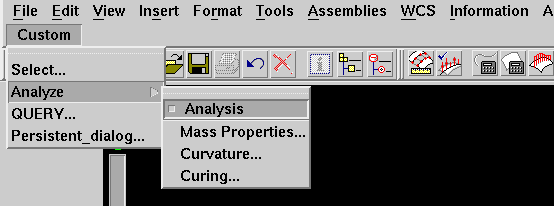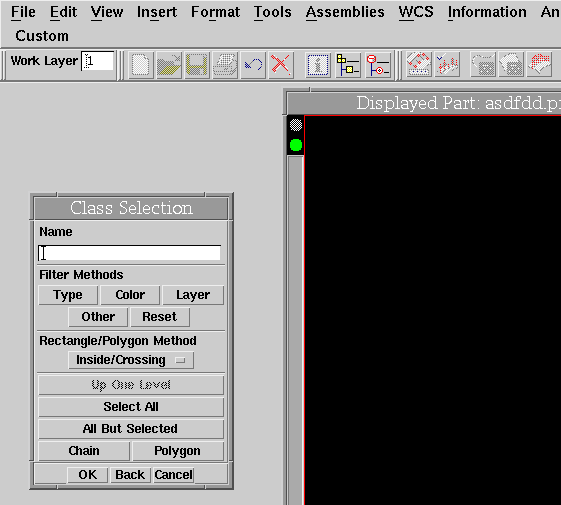Operational Tips and Techniques
Lock & Unlock
This section discusses the essential protocols which Presentation APIs
must follow when using UF_UI_lock_ug_access and UF_UI_unlock_ug_access.
All Presentation APIs must use the lock/unlock protocol when launching
Open C API dialogs and any UIStyler dialogs from a custom dialog not launched
via UF_UI_run_dialog. The lock protocol informs NX that your custom
application intends to execute a sequence of one or more interactive Open C
API routines. NX services a lock request by inhibiting access
to the appropriate menubar items and DA1, until the receipt of an unlock
request. NX special functions are still available at all times.
Each lock request must eventually be paired with a corresponding unlock
request. Even if you do not wish to inhibit your DA1, you must still make
the lock request, since this is the only way for NX to know you
are about to launch a Presentation API from a custom dialog.
When calling multiple Open C dialogs or UIStyler dialogs or some such
combination one after the other within the same callback then you do not
have to wrapper every call with UF_UI_lock_ug_access and UF_UI_unlock_ug_access.
Only the first call to an Open C dialog or UIStyler dialog needs to be
preceded with UF_UI_lock_ug_access and the last call must be followed with
a call to UF_UI_unlock_ug_access.
A UIStyler dialog or an C dialog may not be launched from a custom
application when an NX dialog is displayed. What this means is
if an NX DA2 is currently displayed, such as the Layer Settings
dialog, and you attempt to invoke either a UIStyler dialog or an Open C
dialog then you receive an error when you attempt to lock NX.
This implies that is it is very important to always check the return status
of UF_UI_lock_ug_access. If this is not done and an attempt is made to
launch an Open C API when an error has occurred then unpredictable results
occur.
When you use custom dialogs to launch your UIStyler or Open C dialog
then actions must be taken so that the user of the custom dialog does not
get NX into an unpredictable state. This can happen when a user
has launched a UIStyler or Open C dialog and is able to launch another
Open C dialog from the custom dialog. The lock/unlock protocols are the
first step towards preventing unwanted behavior, because the user can not
launch an unwanted NX dialog. The next step is to do either of
the following actions:
- register a change state function that either unmanages the custom
dialog or greys out any custom dialog items that launch another Open C
or UIStyler dialog.
- call the UF_UI_cancel_uf_dialog along with the XtIntrinsics call XtAppAddTimeOut
in each callback that launches an Open C or UIStyler dialog
Either method is valid and up to the dialog designer. Please refer to
the section on Change State Callbacks and Cancel vs. Dismiss for more complete
details.
Figure 1-2 shows the response that occurs when Custom-->Select
(from Figure 1-1) is pressed from the customized menu hierarchy. The corresponding
callback performs a lock request, displays the Class Selection Dialog until
the user closes it, and then performs an unlock request.

Figure 1-1 Sample Customized Menu Hierarchy

Figure 1-2 Locking NX from Custom Application
Refer to the descriptions of UF_UI_lock_ug_access() for an example on
how to use the lock/unlock protocol with the Presentation APIs.
Lock & Unlock Summary
- Any Open C dialogs and UIStyler dialogs invoked from a custom dialog
must be wrappered with UF_UI_lock_ug_access and UF_UI_unlock_ug_access.
- Multiple calls to Open C dialogs or UIStyler dialogs that occur in
a row do not have to be individually wrappered with the lock protocols.
Only the entire set needs to be wrappered.
- You may not lock NX when an NX owned DA2 is currently
displayed.
- Always check the return status of UF_UI_lock_ug_access.
- After launching an Open C dialog or an UIStyler dialog, actions must
be taken to prevent the user from getting into unpredictable states.
- Open C dialogs and UIStyler dialogs launched from UIStyler dialogs
do not require the lock and unlock mechanism.

